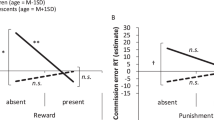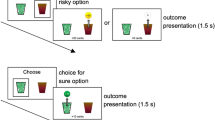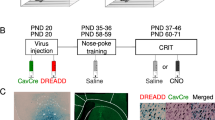Abstract
Adolescence is characterized by making risky decisions. Early lesion and neuroimaging studies in adults pointed to the ventromedial prefrontal cortex and related structures as having a key role in decision-making. More recent studies have fractionated decision-making processes into its various components, including the representation of value, response selection (including inter-temporal choice and cognitive control), associative learning, and affective and social aspects. These different aspects of decision-making have been the focus of investigation in recent studies of the adolescent brain. Evidence points to a dissociation between the relatively slow, linear development of impulse control and response inhibition during adolescence versus the nonlinear development of the reward system, which is often hyper-responsive to rewards in adolescence. This suggests that decision-making in adolescence may be particularly modulated by emotion and social factors, for example, when adolescents are with peers or in other affective ('hot') contexts.
This is a preview of subscription content, access via your institution
Access options
Subscribe to this journal
Receive 12 print issues and online access
$209.00 per year
only $17.42 per issue
Buy this article
- Purchase on Springer Link
- Instant access to full article PDF
Prices may be subject to local taxes which are calculated during checkout







Similar content being viewed by others

References
Steinberg, L. Adolescence, 9th edn. (McGraw-Hill Higher Education, 2010).
Viner, R.M. et al. Adolescence and the social determinants of health. Lancet 379, 1641–1652 (2012).
Giedd, J.N. et al. Brain development during childhood and adolescence: a longitudinal MRI study. Nat. Neurosci. 2, 861–863 (1999).
Gogtay, N. et al. Dynamic mapping of human cortical development during childhood through early adulthood. Proc. Natl. Acad. Sci. USA 101, 8174–8179 (2004).
Shaw, P. et al. Neurodevelopmental trajectories of the human cerebral cortex. J. Neurosci. 28, 3586–3594 (2008).
Raznahan, A. et al. Patterns of coordinated anatomical change in human cortical development: a longitudinal neuroimaging study of maturational coupling. Neuron 72, 873–884 (2011).
Brain Development Cooperative Group. Total and regional brain volumes in a population-based normative sample from 4 to 18 years: the NIH MRI study of normal brain development. Cereb. Cortex 22, 1–12 (2012).
Petanjek, Z. et al. Extraordinary neoteny of synaptic spines in the human prefrontal cortex. Proc. Natl. Acad. Sci. USA 108, 13281–13286 (2011).
Rubia, K. et al. Mapping motor inhibition: conjunctive brain activations across different versions of go/no-go and stop tasks. Neuroimage 13, 250–261 (2001).
Aron, A.R., Behrens, T.E., Smith, S., Frank, M.J. & Poldrack, R. A Triangulating a cognitive control network using diffusion-weighted magnetic resonance imaging (MRI) and functional MRI. J. Neurosci. 27, 3743–3752 (2007).
Luna, B., Garver, K.E., Urban, T.A., Lazar, N.A. & Sweeney, J.A. Maturation of cognitive processes from late childhood to adulthood. Child Dev. 75, 1357–1372 (2004).
Houdé, O., Rossi, S., Lubin, A. & Joliot, M. Mapping numerical processing, reading, and executive functions in the developing brain: an fMRI meta-analysis of 52 studies including 842 children. Dev. Sci. 13, 876–885 (2010).
Hare, T.A. et al. Biological substrates of emotional reactivity and regulation in adolescence during an emotional go-nogo task. Biol. Psychiatry 63, 927–934 (2008).
Luna, B. et al. Maturation of widely distributed brain function subserves cognitive development. Neuroimage 13, 786–793 (2001).
Rubia, K. et al. Functional frontalisation with age: mapping neurodevelopmental trajectories with fMRI. Neurosci. Biobehav. Rev. 24, 13–19 (2000).
Rubia, K. et al. Progressive increase of frontostriatal brain activation from childhood to adulthood during event-related tasks of cognitive control. Hum. Brain Mapp. 27, 973–993 (2006).
Durston, S. et al. A shift from diffuse to focal cortical activity with development. Dev. Sci. 9, 1–8 (2006).
Rachlin, H., Raineri, A. & Cross, D. Subjective probability and delay. J. Exp. Anal. Behav. 55, 233–244 (1991).
Mischel, W.S., Shoda, Y. & Rodriguez, M.I. Delay of gratification in children. Science 244, 933–938 (1989).
Casey, B.J. et al. Behavioral and neural correlates of delay of gratification 40 years later. Proc. Natl. Acad. Sci. USA 108, 14998–15003 (2011).
McClure, S.M., Laibson, D.I., Loewenstein, G. & Cohen, J.D. Separate neural systems value immediate and delayed monetary rewards. Science 306, 503–507 (2004).
Kable, J.W. & Glimcher, P.W. The neural correlates of subjective value during intertemporal choice. Nat. Neurosci. 10, 1625–1633 (2007).
Scheres, A. et al. Temporal and probabilistic discounting of rewards in children and adolescents: effects of age and ADHD symptoms. Neuropsychologia 44, 2092–2103 (2006).
Christakou, A., Brammer, M. & Rubia, K. Maturation of limbic corticostriatal activation and connectivity associated with developmental changes in temporal discounting. Neuroimage 54, 1344–1354 (2011).
Bernoulli, D. Exploitation of a new theory on the measurement of risk. (First published in 1738; translation by Sommer, L.). Econometrika 22, 22–36 (1954).
Rangel, A., Camerer, C. & Montagu, P.R. A framework for studying the neurobiology of value-based decision-making. Nat. Rev. Neurosci. 9, 545–556 (2008). Survey of main concepts in the neuroscience of decision-making research, with more detailed explanations of the underlying economic concepts and their relationship to psychological processes than is possible in the current review, and an introduction to the three valuation systems hypothesized to underlie decision-making based on different associative processes: Pavlovian, habitual and goal-directed as well as their interactions—competitive and otherwise.
Tversky, A. & Kahneman, D. The framing of decisions and the psychology of choice. Science 211, 453–458 (1981).
Kennerley, S.W., Behrens, T.E.J. & Wallis, J.D. Double dissociation of value computations in orbitofrontal and anterior cingulate cortex neurons. Nat. Neurosci. 14, 1581–1589 (2011).
Tversky, A. & Kahneman, D. Loss aversion in riskless choice: a reference dependent model. Q. J. Econ. 106, 1039–1061 (1991).
Kahneman, D. & Tversky, A. Prospect theory: an analysis of decision under risk. Econometrika 47, 263–291 (1979).
Breiter, H.C., Aharon, I., Kahneman, D., Dale, A. & Shizgal, P. Functional imaging of neural responses to expectancy and experience of monetary gains and losses. Neuron 30, 619–639 (2001).
Everitt, B.J. & Robbins, T.W. Neural systems of reinforcement for drug addiction: from actions to habits to compulsion. Nat. Neurosci. 8, 1481–1489 (2005).
Sesack, S.R. & Grace, A.A. Cortico-basal ganglia reward network: microcircuitry. Neuropsychopharmacology 35, 27–47 (2010).
Haber, S.N. & Knutson, B. The reward circuit: linking primate anatomy and human imaging. Neuropsychopharmacology 35, 4–26 (2010).
Bechara, A., Damasio, A.R., Damasio, H. & Anderson, S.W. Insensitivity to future consequences following damage to human prefrontal cortex. Cognition 50, 7–15 (1994).
Damasio, A. Descartes' Error: Emotion, Reason and the Human Brain (G.P. Putnam, New York, 1994).
Harbaugh, W.T., Krause, K. & Vesterlund, L. Risk attitudes of children and adults: choices over small and large probability gains and losses. Exp. Econ. 5, 53–84 (2002).
Van Leijenhorst, L., Westenberg, P.M. & Crone, E.A. A developmental study of risky decisions on the cake gambling task: age and gender analyses of probability estimation and reward evaluation. Dev. Neuropsychol. 33, 179–196 (2008).
Casey, B.J., Jones, R.M. & Hare, T.A. The adolescent brain. Ann. NY Acad. Sci. 1124, 111–126 (2008).
Figner, B., Mackinlay, R.J., Wilkening, F. & Weber, E.U. Affective and deliberative processes in risky choice: age differences in risk taking in the Columbia Card Task. J. Exp. Psychol. Learn. Mem. Cogn. 35, 709–730 (2009).
Cauffman, E. et al. Age differences in affective decision making as indexed by performance on the Iowa Gambling Task. Dev. Psychol. 46, 193–207 (2010).
Schultz, W. & Dickinson, A. Neuronal coding of prediction errors. Annu. Rev. Neurosci. 23, 473–500 (2000).
Wise, R.A. Dopamine, learning and motivation. Nat. Rev. Neurosci. 5, 483–494 (2004).
Daw, N.D., Kakade, S. & Dayan, P. Opponent interactions between serotonin and dopamine. Neural Netw. 15, 603–616 (2002).
Fellows, L.K. & Farrah, M.J. Ventromedial frontal cortex mediates affective shifting in humans: evidence from a reversal learning paradigm. Brain 126, 1830–1837 (2003).
Clarke, H.F., Robbins, T.W. & Roberts, A.C. Lesions of the medial striatum in monkeys produce perseverative impairments during reversal learning similar to those produced by lesions of the orbitofrontal cortex. J. Neurosci. 28, 10972–10982 (2008).
Logan, G.D. On the ability to inhibit thought and action: a user?s guide to the stop signal paradigm. in Inhibitory Processes in Attention, Memory and Language (eds. Dagenbach, D. & Carr, T.H.) 189–236 (Academic Press, San Diego, 1994).
Clark, L. et al. Association between response inhibition and working memory in adult ADHD: a link to right frontal cortex pathology? Biol. Psychiatry 61, 1395–1401 (2007).
Billieux, J., Gay, P., Rochat, L. & van der Linden, N. The role of urgency and its underlying psychological mechanisms in problematic behaviors. Behav. Res. Ther. 48, 1085–1096 (2010).
Eysenck, S.B. & Eysenck, H.J. Impulsiveness and venturesomeness: their position in a dimensional system of personality description. Psychol. Rep. 43, 1247–1255 (1978).
Rogers, R.D. et al. Dissociable deficits in the decision-making cognition of chronic amphetamine abusers, opiate abusers, patients with focal damage to prefrontal cortex, and tryptophan-depleted normal volunteers: evidence for monoaminergic mechanisms. Neuropsychopharmacology 20, 322–339 (1999).
Manes, F. et al. Decision-making processes following damage to the prefrontal cortex. Brain 125, 624–639 (2002).
Clark, L. et al. Differential effects of insular and ventromedial prefrontal cortex damage on risky decision-making. Brain 131, 1311–1322 (2008).
Hsu, M., Bhatt, M., Adolphs, R. & Camerer, C. Neural systems responding to degrees of uncertainty in human decision-making. Science 310, 1680–1683 (2005).
Huettel, S.A., Song, A.W. & McCarthy, G. Decisions under uncertainty: probabilistic context influences activation of prefrontal and parietal cortices. J. Neurosci. 25, 3304–3311 (2005).
Levy, I., Snell, J., Nelson, A.J., Rusticini, A. & Glimcher, P.W. Neural representations of subjective value under risk and ambiguity. J. Neurophysiol. 103, 1036–1047 (2010).
Platt, M.L. & Glimcher, P.W. Neural correlates of decision variables in parietal cortex. Nature 400, 233–238 (1999).
Galvan, A. et al. Earlier development of the accumbens relative to orbitofrontal cortex might underlie risk-taking behavior in adolescents. J. Neurosci. 26, 6885–6892 (2006).
Gladwin, T.E., Figner, B., Crone, E.A. & Wiers, R.W. Addiction, adolescence, and the integration of control and motivation. Dev. Cogn. Neurosci. 1, 364–376 (2011).
Van Leijenhorst, L. et al. Adolescent risky decision-making: neurocognitive development of reward and control regions. Neuroimage 51, 345–355 (2010).
Bjork, J.M. et al. Incentive-elicited brain activation in adolescents: similarities and differences from young adults. J. Neurosci. 24, 1793–1802 (2004).
Geier, C.F., Terwilliger, R., Teslovich, T., Velanova, K. & Luna, B. Immaturities in reward processing and its influence on inhibitory control in adolescence. Cereb. Cortex 20, 1613–1629 (2010).
Doremus-Fitzwater, T.L., Varlinskaya, E.I. & Spear, L.P. Motivational systems in adolescence: possible implications for age differences in substance abuse and other risk-taking behaviors. Brain Cogn. 72, 114–123 (2010).
Philpot, R.M. & Wecker, L. Dependence of adolescent novelty-seeking behavior on response phenotype and effects of apparatus scaling. Behav. Neurosci. 122, 861–875 (2008).
Sturman, D.A. & Moghaddam, B. Striatum processes reward differently in adolescents versus adults. Proc. Natl. Acad. Sci. USA 109, 1719–1724 (2012).
Cohen, J.R. et al. A unique adolescent response to reward prediction errors. Nat. Neurosci. 13, 669–671 (2010). This fMRI study dissociated decision value and prediction error in a learning paradigm in 67 participants aged 8–30 years.
Somerville, L.H., Jones, R.M. & Casey, B.J. A time of change: behavioral and neural correlates of adolescent sensitivity to appetitive and aversive environmental cues. Brain Cogn. 72, 124–133 (2010).
Somerville, L.H., Hare, T. & Casey, B.J. Frontostriatal maturation predicts cognitive control failure to appetitive cues in adolescents. J. Cogn. Neurosci. 23, 2123–2134 (2011).
Coricelli, G., Critchley, H.D., Joffily, M., O'Doherty, J.P., Sirigu, A. & Dolan, R. J. Regret and its avoidance: a neuroimaging study of choice behavior. Nat. Neurosci. 8, 1255–1262 (2005).
Camille, N. et al. Striatal sensitivity to personal responsibility in a regret-based decision-making task. Cogn. Affect. Behav. Neurosci. 10, 460–469 (2010).
Baird, A.A. & Fugelsang, J.A. The emergence of consequential thought: evidence from neuroscience. Phil. Trans. R. Soc. Lond. B 359, 1797–1804 (2004).
Burnett, S., Bault, N., Coricelli, G. & Blakemore, S.J. Adolescents′ heightened risk-seeking in a probabilistic gambling task. Cogn. Dev. 25, 183–196 (2010).
Crone, E.A., Bullens, L., van der Plas, E.A., Kijkuit, E.J. & Zelazo, P.D. Developmental changes and individual differences in risk and perspective taking in adolescence. Dev. Psychopathol. 20, 1213–1229 (2008).
Paulsen, D.J., Platt, M.L., Huettel, S.A. & Brannon, E.M. Decision-making under risk in children, adolescents, and young adults. Front. Psychol. 2, 72 (2011).
Camerer, C.F. Behavioral Game Theory: Experiments in Strategic Interaction. (Princeton University Press, 2003).
Guth, W., Schmittberger, R. & Schwarze, B. An experimental analysis of Ultimatum Bargaining. J. Econ. Behav. Organ. 3, 367–388 (1982).
Jensen, K., Call, J. & Tomasello, M. Chimpanzees are rational maximizers in an Ultimatum Game. Science 318, 107–109 (2007).
Sanfey, A., Rilling, J.K., Aronson, J.A., Nystrom, L.E. & Cohen, J.D. Neural basis of economic decision-making in the Ultimatum Game. Science 300, 1755–1758 (2003).
Greene, J.D., Sommerville, R.B., Nystrom, L.E., Darley, J.M. & Cohen, J.D. An fMRI investigation of emotional engagement in moral judgement. Science 293, 2105–2108 (2001).
Gardner, M. & Steinberg, L. Peer influence on risk taking, risk preference, and risky decision making in adolescence and adulthood: an experimental study. Dev. Psychol. 41, 625–635 (2005).
Chein, J., Albert, D., O'Brien, L., Uckert, K. & Steinberg, L. Peers increase adolescent risk taking by enhancing activity in the brain's reward circuitry. Dev. Sci. 14, F1–F10 (2011).
Dumontheil, I., Apperly, I.A. & Blakemore, S.-J. Online usage of theory of mind continues to develop in late adolescence. Devel. Sci. 13, 331–338 (2010).
Frith, C.D. The social brain? Phil. Trans. R. Soc. Lond. B 362, 671–678 (2007).
Blakemore, S.J. The social brain in adolescence. Nat. Rev. Neurosci. 9, 267–277 (2008).
Wang, A.T., Lee, S.S., Sigman, M. & Dapretto, M. Developmental changes in the neural basis of interpreting communicative intent. Soc. Cogn. Affect. Neurosci. 1, 107–121 (2006).
Blakemore, S.J., den Ouden, H., Choudhury, S. & Frith, C. Adolescent development of the neural circuitry for thinking about intentions. Soc. Cogn. Affect. Neurosci. 2, 130–139 (2007).
Burnett, S., Bird, G., Moll, J., Frith, C. & Blakemore, S.J. Development during adolescence of the neural processing of social emotion. J. Cogn. Neurosci. 21, 1736–1750 (2009).
Güroğlu, B., van den Bos, W. & Crone, E.A. Fairness considerations: increasing understanding of intentionality during adolescence. J. Exp. Child Psychol. 104, 398–409 (2009).
Van den Bos, W., van Dijk, E., Westenberg, M., Rombouts, S.A. & Crone, E.A. Changing brains, changing perspectives: the neurocognitive development of reciprocity. Psychol. Sci. 22, 60–70 (2011). This was the first study to show asynchronous development of the relative contribution of different cortical regions to trust decisions.
Pfeifer, J.H. & Allen, N.B. Arrested development? Reconsidering dual-systems models of brain function in adolescence and disorders. Trends Cogn. Sci. 16, 322–329 (2012).
Blakemore, S.J. Imaging brain development: the adolescent brain. Neuroimage 61, 397–406 (2012).
Harris, J.J., Reynell, C. & Attwell, D. The physiology of developmental changes in BOLD functional imaging signals. Dev. Cogn. Neurosci. 1, 199–216 (2011).
Paus, T., Keshavan, M. & Giedd, J.N. Why do many psychiatirc disorders emerge during adolescence? Nat. Rev. Neurosci. 9, 947–957 (2008).
Whelan, R. et al. Adolescent impulsivity phenotypes characterized by distinct brain networks. Nat. Neurosci. (in the press).
Clark, L., Manes, F., Antoun, N., Sahakian, B.J. & Robbins, T.W. The contributions of lesion laterality and lesion volume to decision-making impairment following frontal lobe damage. Neuropsychologia 41, 1474–1483 (2003).
Clark, L., Lawrence, A.J., Astley-Jones, F. & Gray, N. Gambling near-misses enhance motivation to gamble and recruit win-related brain circuitry. Neuron 61, 481–490 (2009).
Pfeifer, J.H., Lieberman, M.D. & Dapretto, M. “I know you are but what am I?!”: neural bases of self- and social knowledge retrieval in children and adults. J. Cogn. Neurosci. 19, 1323–1337 (2007).
Pfeifer, J.H. et al. Neural correlates of direct and reflected self-appraisals in adolescents and adults: when social perspective-taking informs self-perception. Child Dev. 80, 1016–1038 (2009).
Sebastian, C.L. et al. Neural processing associated with cognitive and affective Theory of Mind in adolescents and adults. Soc. Cogn. Affect. Neurosci. 7, 53–63 (2012).
Moor, B.G. et al. Neurodevelopmental changes of reading the mind in the eyes. Soc. Cogn. Affect. Neurosci. 7, 44–52 (2012).
Acknowledgements
S.-J.B. is funded by the Royal Society and the Leverhulme Trust, UK. The Behavioural and Clinical Neuroscience Institute, Cambridge, UK is co-funded by the Medical Research Council and the Wellcome Trust. We thank S. Burnett Heyes, I. Dumontheil, A.L. Goddings, E.J. Kilford, K. Mills and N. Wright for commenting on previous versions of the manuscript, T. Wager for help with the meta-analysis using Neurosynth (http://neurosynth.org/), and L. Clark, J. Chein and L. Somerville for help with figures.
Author information
Authors and Affiliations
Corresponding author
Ethics declarations
Competing interests
T.W.R. discloses Cambridge Cognition consultancy and royalties for CANTAB. T.W.R. discloses consultancy and research grants received from E. Lilly Inc., Lundbeck and GlaxoSmithKline.
Rights and permissions
About this article
Cite this article
Blakemore, SJ., Robbins, T. Decision-making in the adolescent brain. Nat Neurosci 15, 1184–1191 (2012). https://doi.org/10.1038/nn.3177
Published:
Issue Date:
DOI: https://doi.org/10.1038/nn.3177
This article is cited by
-
Puberty Suppression for Pediatric Gender Dysphoria and the Child’s Right to an Open Future
Archives of Sexual Behavior (2024)
-
Towards a Unified Account of Aberrant Salience in Psychosis: Proximate and Evolutionary Mechanisms
Evolutionary Psychological Science (2024)
-
Risk taking for potential losses but not gains increases with time of day
Scientific Reports (2023)
-
Driving behaviors and related factors on emerging adults: a narrative review
Discover Psychology (2023)
-
Maladaptive emotion-focused coping and anxiety in children: The moderating role of authoritative parenting
Current Psychology (2023)


